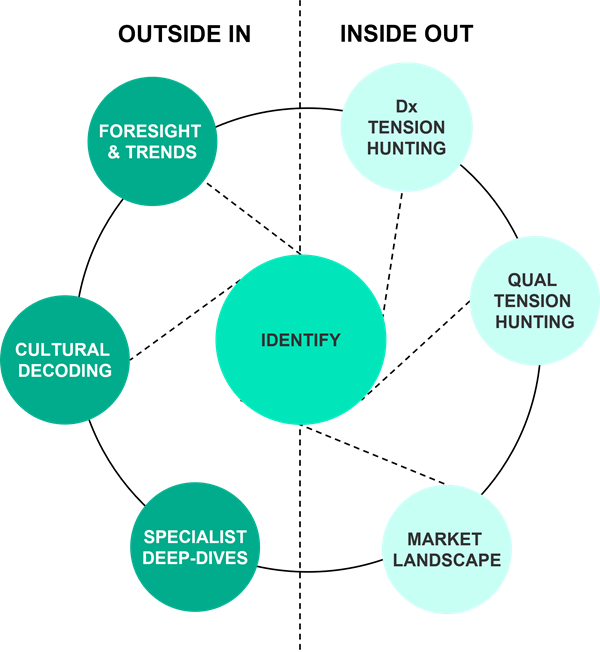History shows that innovators win in times of crisis and beyond. From 2008-2011, after the last great recession, winning brands launched 60% more significant innovations than competitors, and those brands perceived as highly innovative have grown 7x faster than competitors. 63% of over performing businesses take a long-term view of the future, which Kantar has found to be the best growth predictor.
While the value of innovation may seem irrefutable, many perceive innovation as slow, expensive, risky, resource-intensive, and most importantly, failing to deliver results. So how do you innovate successfully and with agility?
Kantar has found that too many businesses are focused on a narrow definition of agile - worshiping speed alone, ultimately at the cost of success, making it the most over-used and under-achieving buzzword in innovation today. Given the high failure rate of innovation, it can feel like a gamble to embrace new mindsets – and often an expensive one. Here are some of the secrets to beating the long odds in your innovation journey.
1) Agile thinking helps you navigate the crowd
Agile thinking in the preliminary stages of an innovation process will give you a strategic advantage, and too often teams rush past the all-important discovery phase. When this phase of deciding where to play is rushed, there is an elevated risk of missing a critical piece of information – or developing a too superficial view of the playing field. There may not be a clear definition of customer problems – teams are solving superficial problems and not the all-important problem behind the problem. The opportunity areas are obvious, surface-level, and likely "crowded". They are unlikely to birth Meaningfully Different innovations.
Instead of speeding past this phase, the Agile Thinking first philosophy exhorts us to look beyond ‘grey space’ that everyone can see and dig deeper to recognize blind spots and potential true white spaces.
Understand the landscape and how your route fits into it:
- Look beyond the superficial read: because your competition sees exactly what you see there
- Identify blind spots and dig deep to understand what they might mean, and what that means for your next move
- Expand your view with both inside out + outside in perspectives: creating a solid foundation that will accelerate the rest of your journey

Inside Out thinking takes account of your brand’s current power and potential, then envisages something better.
Outside In thinking seeks to expand your frame of reference, exploring how people’s lives and attitudes are changing, and how other categories have been re-imagined.
Together, they form a rich foundation of empathy and understanding that anchors stretchy and distinctive future possibilities in a credible and ownable space for your brand.
We look deeply from the inside-out, understanding the landscape of a category, consumer, and brand as it is today and using behavioral insights to get behind the inevitable ‘say-do’ gaps. But we also bring the outside-in – exploring wider future dynamics, cultural shifts, and emerging developments that may impact future opportunities.
This agility is where that spark of corporate imagination is most critical in the innovation process – and it can still be done at pace. Leveraging tools like AI, trends and foresight frameworks, search analytics, social listening and more can very quickly paint a picture of the landscape – and give you much more robust intelligence with which to place your bets.
2) Agile thinking helps you avoid common innovation pitfalls
You deeply understand your consumer, their expectations, problems, needs, motivations. So what next?
Concept development and testing is one of the most tempting moments in an innovation journey to go full throttle for speed – throwing ideas at the (virtual testing) wall to see what sticks, and then moving into rapid optimization.
If you are working with a speed-only supplier – you are simply playing a game of statistics. Agile Thinking in this phase of development, combined with Agile Process, is about collecting truly iterative and additive insights that help us to test less, and test better.
Building a culture of iterative learning is a necessity. Revolving around the consumer needs a demand for deeper, richer insights that deliver intelligence on real-world consumer actions. But as we all know, consumers’ opinions and habits change rapidly, be ready to pivot, adapt and move forward.
The ability to adapt to change and new learnings is critical. Proceed, Pause or Pivot. Pivots sound great in theory - but can be difficult in practice. Particularly when leaders and stakeholders have already made commitments on output or outcomes a team is PIVOTING FROM. It can be tempting to seek a binary go/no go and look past new learnings that potentially introduce ambiguity/uncertainty.
3) Agile thinking helps you work smart to increase your opportunity odds
So then to action: the third secret is that Agile Thinking builds stronger Innovation teams and culture, vs an agile process alone.
Avoid the trap of running fast at the wrong target. A fast concept test process does not mean your to-market success will be fast, too. In fact, teams can be prevented from making smart decisions by the pure pace and short-term expectations that ‘agile process’ alone can create.
Strong innovation teams rely on thinking, not process:
- Know how to identify gaps, build knowledge, and pivot when needed
- Empowered to act to minimize risk at all junctures
Instead, building a culture of agile thinking helps to empower teams to identify gaps, build knowledge, and act when needed to maximize potential and minimize risk.
By elevating quality thinking over fast process, your organization can avoid the trap of running fast at the wrong target – and spending a lot of money in the process – and instead, make smarter decisions when going into the marketplace. Prioritizing Agile Thinking over Agile Process ultimately means prioritizing speed to success, over speed to market.
To learn more, join our LinkedIn Live session on March 16 to learn how innovative companies transform their insights.

